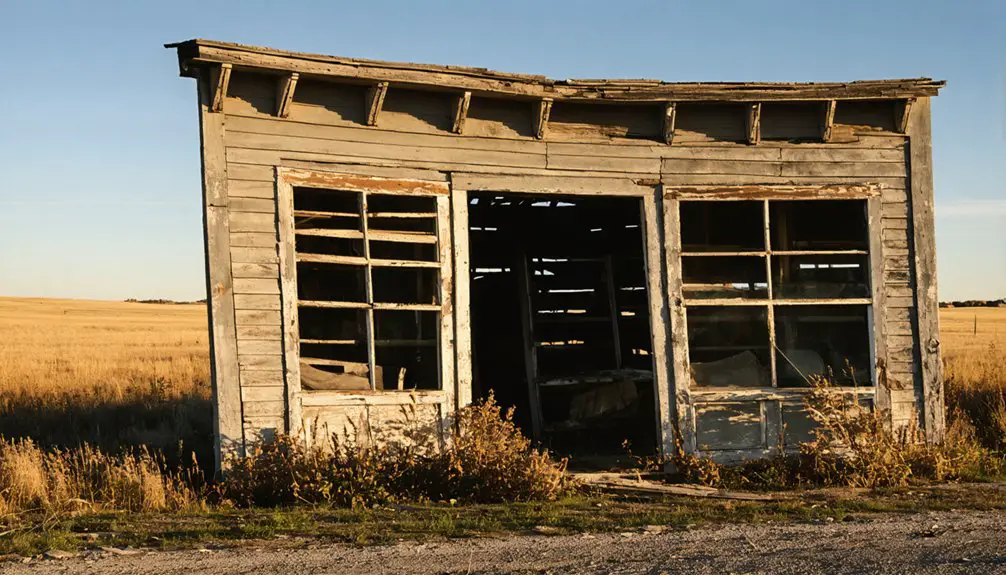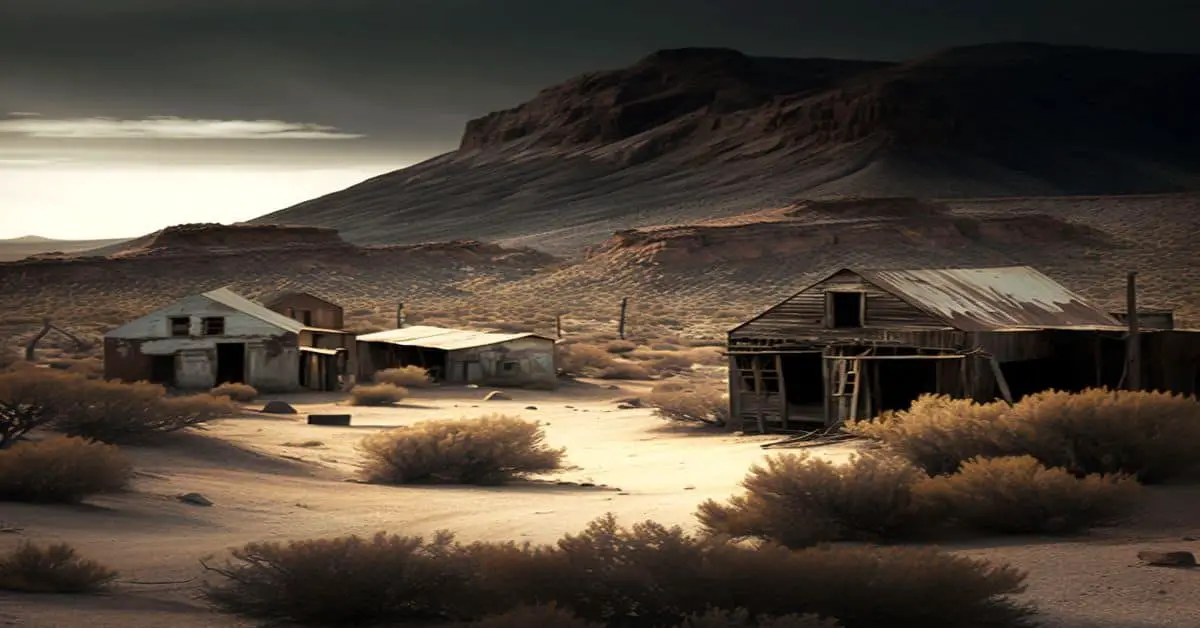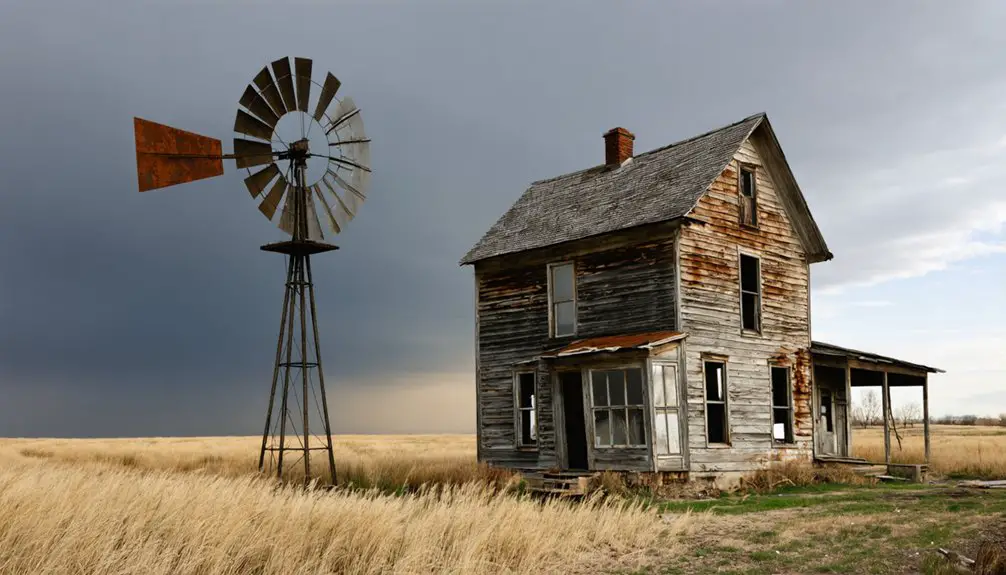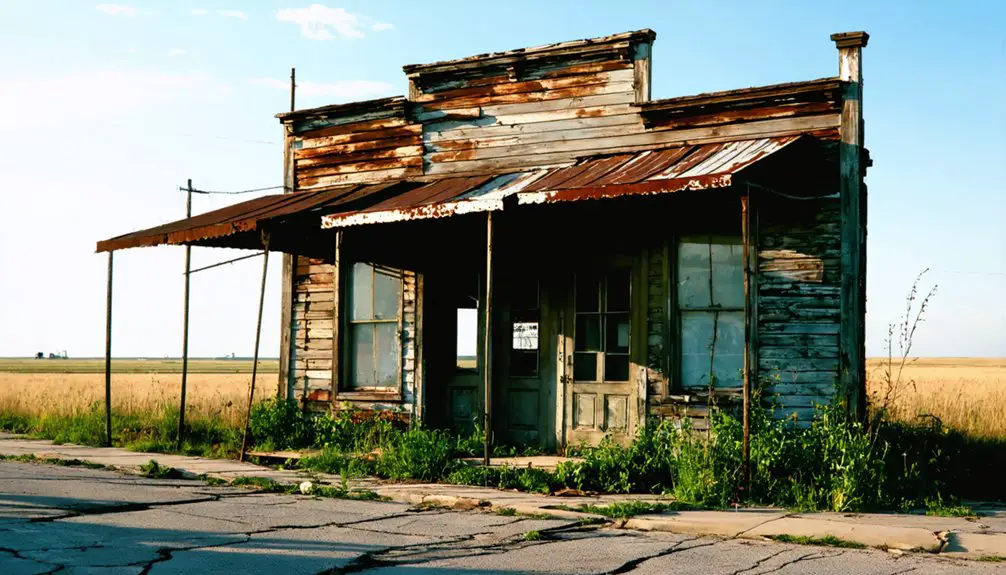You’ll find Bookwalter, Nebraska’s remnants scattered across Pawnee County’s prairie landscape, where John W. Bookwalter’s 1879 agricultural dream once flourished. His ambitious vision included 60,000 acres of farmland organized around a central village, complete with urban amenities and shared farming resources. Though the railroad’s arrival in 1888 initially sparked growth, the community gradually faded. Today, weathered foundations, railway grades, and a lone schoolhouse shell reveal traces of this fascinating ghost town’s story.
Key Takeaways
- Bookwalter was founded in 1879 by John W. Bookwalter as an agricultural community spanning 60,000 acres across Nebraska.
- The town declined after World War I due to railroad consolidation, economic challenges, and residents moving to larger urban areas.
- Physical remains include stone foundations, old railway grades, and remnants of the post office that closed in 1919.
- The community was designed around cooperative farming with 80-acre plots and shared labor arrangements among neighboring farms.
- The site now features historical markers, archaeological discoveries, and preserved structures that document Nebraska’s ghost town heritage.
The Birth of Bookwalter’s Agricultural Dream
The fertile prairies of Pawnee County beckoned to John W. Bookwalter in 1879, igniting his vision of an agricultural utopia. You can imagine his excitement as he amassed 15,000 acres across Pawnee and Gage counties, eventually expanding to 60,000 acres throughout Nebraska.
Despite the agricultural challenges faced by early settlers, this “splendid corn country” held immense potential. The region’s transformation accelerated with mechanization impact in the mid-1880s, as sulky plows and threshing machines replaced manual labor. The area’s rich loess soil deposits made it exceptionally fertile for farming ventures. Like many historical developments documented in The Journal of American History, this agricultural transformation marked a significant shift in the region’s economic landscape.
Bookwalter dreamed of 80-acre farms clustered around a central village, complete with urban amenities like libraries and theaters. He’d watched farmers from Indiana, Ohio, and Illinois adapt to these prairie lands, and now he yearned to create something revolutionary – a community that would blend the best of rural and city life.
John W. Bookwalter’s Vision for a Farming Community
You’d find Bookwalter’s cooperative village model revolutionary for its time, envisioning farms without conventional fences and promoting shared agricultural labor among neighbors.
His design called for the entire tract to be cultivated like an immense garden, with farmers working together to maintain both the land and community roads. The introduction of labor-saving machinery transformed how efficiently these cooperative farms could operate.
Through organized meetings and shared knowledge at the town hall, you would’ve seen farmers improving their methods while building the social bonds that Bookwalter believed were essential for agricultural success. In 1947, one tenant farmer, Hank de Koning, faced a challenging dry growing season while renting from Bookwalter’s land holdings.
Cooperative Village Model Plan
As Nebraska’s frontier expanded in the late 19th century, John W. Bookwalter envisioned a revolutionary cooperative farming community where eighty-acre farms would connect without fences, creating a vast garden-like landscape. His model emphasized collective responsibility, with farmers working together to maintain roads, control weeds, and maximize productivity.
You’d have found a vibrant hub at the town hall, which served as a cultural center complete with a library and theater. The plan encouraged farmers to break free from isolation through regular gatherings to share knowledge and plan together. Similar to the ideals promoted at the Trans-Mississippi Exposition, the community aimed to showcase the agricultural capabilities of the Western region.
A formal community governance structure would oversee operations, though reality proved different. While the ideal of clustered homesteads gave way to dispersed quarter sections, Bookwalter’s dream of an elevated rural lifestyle challenged traditional farming patterns of the time.
Agricultural Labor Sharing Ideas
While John W. Bookwalter’s original vision for concentrated village living evolved, the spirit of cooperation thrived through practical labor sharing.
You’d find farmers regularly pooling their resources, using shared equipment like harvesters and binders to tackle the demanding seasonal work. When it came time to shell corn, saw wood, or bring in the hay, neighbors would gather to help one another through informal reciprocal arrangements. Like early settlers in Adams County who faced extreme weather conditions, farmers had to band together to survive the harsh elements.
This collaborative approach wasn’t limited to just shared equipment and labor exchange.
You could hear the distinctive ring patterns on party telephone lines, connecting dispersed farms and coordinating assistance when needed.
The community’s social fabric strengthened through gatherings at rural schoolhouses, churches, and social events, where farmers exchanged knowledge and supported each other through the challenges of agricultural life.
Life in Early Bookwalter: Commerce and Daily Affairs
The bustling railroad line that once cut through Bookwalter shaped the town’s early commercial identity, connecting local farmers to broader markets and bringing essential supplies to the community.
You’d find yourself trading at establishments like Halderman’s Store, which later relocated alongside the railway to better serve the area’s needs.
Daily life centered around scattered farmsteads rather than a concentrated village, with community interactions revolving around the local schoolhouse and church activities.
Rural families found their social connections through church gatherings and school events, living apart yet bound by these community touchstones.
You might’ve attended events at the fairgrounds, where the floral hall hosted agricultural exhibitions before its conversion to a barn.
As economic challenges emerged after World War I and rail service declined, you’d have shifted your trading to larger hubs like Pawnee City and Beatrice, marking the beginning of Bookwalter’s gradual transformation into a ghost town.
The Railroad’s Rise and Fall
During the harsh blizzards of 1888, construction crews from the Kansas City, Wyandotte, and Northwestern Railroad laid tracks through what would become Bookwalter, forever changing the landscape of this Nebraska prairie.
The railroad logistics were strategic, connecting agricultural regions and supporting John Bookwalter’s vision of model farm communities along the route.
You’d have witnessed the town’s initial optimism as the railroad brought mechanized farming equipment and established essential shipping connections. The depot’s construction promised economic growth and connectivity.
However, town dynamics shifted unexpectedly – instead of clustering near the rails, farmers spread across quarter sections. As railroad companies consolidated and Union Pacific absorbed the line, services dwindled.
Without reliable rail transport, Bookwalter’s dreams of becoming a thriving agricultural hub faded, leaving only scattered remnants of its railroad-founded past.
Remnants and Relics of a Lost Town

If you visit Bookwalter today, you’ll find the frame schoolhouse standing as the most prominent survivor of this once-thriving Nebraska town.
Like many communities established during the railroad expansion, Bookwalter’s fate was tied to changing transportation patterns.
Like the Amboy Mill that operated until the 1940s, the concrete steps of the old church, which burned in the 1940s, and scattered foundation remnants offer silent testimony to the community’s past.
A solitary farmhouse near the original town site and two grain elevator locations complete the physical legacy of this agricultural commune, though most structures have vanished into history.
Physical Traces Today
Modern visitors to Bookwalter’s former site can still discover scattered remnants of this once-thriving Nebraska community.
You’ll find stone and brick foundations dotting the prairie landscape, while old railway grades trace the path of the Kansas City, Wyandotte, and Northwestern Railroad. Physical remnants of the post office building, which closed its doors in 1919, stand as silent sentinels of the past. Like many Nebraska communities experiencing rural population decline, Bookwalter gradually faded as residents moved to larger urban areas. The town shares its name with unincorporated communities in both Nebraska and Ohio.
As you explore, you’ll encounter these enduring traces of history:
- Weathered farmstead structures and quarter section boundary markers peek through native grassland
- Historical markers and plaques installed by local societies help chart your discovery
- Buried artifacts, from household items to railroad hardware, continue surfacing after rain
Today’s visitors can use GPS coordinates to navigate the site, where drone mapping and archaeological surveys preserve Bookwalter’s legacy for future generations.
Preserving Historical Structures
The preservation of Bookwalter’s historical structures stands as a symbol of Nebraska’s commitment to protecting its ghost town heritage. You’ll find the frame schoolhouse’s shell, once bustling with students and community gatherings, among the most prominent remnants still standing.
The church’s cement steps, surviving a 1940s fire, and various building foundations offer glimpses into the town’s original layout.
Historical documentation efforts have been vital in maintaining Bookwalter’s legacy. Through state archives, photographs, and detailed records, you can trace the architectural preservation needs of the remaining structures.
While challenges like natural decay and limited funding restrict full restoration, the preservation work continues. The nearby farmhouse provides valuable insights into the period’s residential architecture, helping you understand how this unique agricultural commune once thrived.
Legacy of a Great Plains Experiment
Many agricultural experiments dotted America’s Great Plains during the late 1800s, but Bookwalter’s vision stood out as a unique attempt to reshape rural society.
John Bookwalter’s dream of communal farming centered on eighty-acre plots where families would work together, sharing resources and knowledge. Though his agricultural ideals didn’t survive in their original form, they left an enduring impact on Nebraska’s farming culture.
- The experiment challenged traditional farming methods by promoting cooperative rather than isolated homesteading.
- Educational opportunities and social structures were designed to keep rural youth connected to the land.
- The concept influenced modern farm organizations and cooperative approaches still seen today.
Even as physical traces of Bookwalter have vanished, its spirit lives on in Nebraska’s agricultural communities, reminding us of a bold vision for rural freedom and collaboration.
Frequently Asked Questions
What Happened to John Bookwalter’s Relatives After Inheriting the Divided Land?
After parting ways through inheritance disputes, you’d find Bookwalter’s relatives scattering like seeds in the wind, managing their divided parcels independently while embracing typical Nebraska farming practices rather than communal living.
Were There Any Notable Crimes or Conflicts During Bookwalter’s Active Years?
You won’t find any documented crime incidents or historical conflicts during this era – historical records focus purely on farming activities and community development rather than social unrest or criminal matters.
How Many Students Typically Attended the Bookwalter Schoolhouse?
You’ll find school attendance typically ranged from 15 to 25 students during peak periods, making a meaningful educational impact as children gathered daily to learn together in the one-room schoolhouse.
What Crops Were Primarily Grown by Farmers in the Bookwalter Area?
You’d find farmers practicing crop rotation with corn as their main crop, alongside wheat, alfalfa, and soybeans. Their farming techniques adapted to both bottomland and upland areas for maximum yields.
Did Any Original Bookwalter Families Continue Living Nearby After Its Decline?
Like roots spreading from a fallen tree, you’ll find Bookwalter descendants stayed anchored to their family farmlands near the old town site, adapting to life around nearby settlements after 1915.
References
- https://history.nebraska.gov/wp-content/uploads/2017/10/doc_publications_NH1973Bookwalter.pdf
- https://history.nebraska.gov/publications_section/bookwalter-a-model-farm-community/
- https://www.familysearch.org/en/wiki/Pawnee_County
- https://kids.kiddle.co/Bookwalter
- https://wikipedia.nucleos.com/viewer/wikipedia_en_all/A/Bookwalter
- http://www.kancoll.org/books/andreas_ne/pawnee/pawnee-p1.html
- https://www.jstor.org/stable/2936872
- https://www.jstor.org/stable/967301
- https://trans-mississippi.unl.edu/texts/view/transmiss.book.haynes.1910.html
- https://www.tablerockhistoricalsociety.com/hank-de-koning.html



